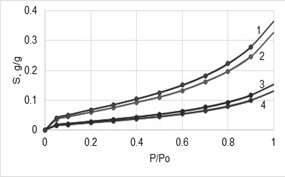STUDY OF ISOTHERMS OF WATER VAPOR SORPTION FOR HYDROPHILIC POLYMERS
UDC 547.458+678.744:544.723
Abstract
Various models and equations of water vapor (WV) sorption for hydrophilic polymers were considered. However, these models often do not correspond to the sorption mechanism. This study is based on the thermodynamics in binary systems and the Van Krevelen method of polar group contributions in the sorption of WV. Moreover, it was shown that the mechanism of WV sorption by various hydrophilic polymers is the absorption of water molecules in the volume of amorphous domains of these polymers. As a result, a universal physicochemical equation was proposed allowing adequately to describe the sorption isotherms of WV by amorphous hydrophilic polymers knowing only the chemical formulas of repeating units of these polymers. To calcu-late the sorption isotherms for semicrystalline polymer samples, it is necessary to use an additional parameter, namely the degree of amorphicity (Y). The adequacy of the derived equation was verified for samples of cellulose and other natural polysaccharides, as well as for samples of synthetic hydrophilic polymers such as polyvinyl alcohol, polyamide-6, and polycaprolactone having various Y-values. The verification showed that the experimental isotherms are almost identical to the isotherms calculated by the universal equation.
Downloads
Metrics
References
Sionkowska A. Progress in Polym. Sci., 2011, vol. 36, pp. 1254–1276. DOI: 10.1016/j.progpolymsci.2011.05.003.
Sazali N., Ibrahim H., Jamaludin A.S. et al. Mater. Sci. Eng., 2020, vol. 788, pp. 1–15. DOI: 10.1088/1757-899X/788/1/012047.
Schmidt B. Polymers, 2019, vol. 11, pp. 693–698. DOI: 10.3390/polym11040693.
Grunin Y.B., Grunin L.Y., Schiraya V.Y. et al. Biores. Bioprocess, 2020, vol. 7, pp. 1–11. DOI: 10.1186/s40643-020-00332-8.
Andrade R.D., Lemus R., Pérez C. Vitae, 2011, vol. 18, pp. 325–334.
Papkov S.P., Fainberg E.Z. Vzaimodeystviye tsellyulozy i tsellyuloznykh materialov s vodoy. [Interaction of cellulose and cellulosic materials with water]. Moscow, 1976, 232 p. (in Russ.).
Timmermann E.O. Colloid Surface, 2003, vol. 220, pp. 235–260. DOI: 10.1016/S0927-7757(03)00059-1.
Czepirsky L., Komarowska-Czepirska E., Szymonska J. Appl. Surface. Sci., 2002, vol. 196, pp. 150–153. DOI: 10.1016/S0169-4332(02)00050-8.
Brousse M.M., Linares R.A., Vergara M.L., Nieto A.B. RECyT, 2017, vol. 19, pp. 29–37.
Blahovec J., Yanniotis S. Food Bioprocess Technol., 2008, vol. 1, pp. 82–90. DOI: 10.1007/s11947-007-0012-3.
Roja J., Moren S., Lopez A. J. Pharm. Sci. Res., 2011, vol. 3, pp. 1302–1309.
Broudin M., Le Saux V., Le Gac Pierre-Yves L. et al. Polymer Testing, 2015, vol. 171, pp. 87–95. DOI: 10.1016/j.polymertesting.2015.02.004.
Hill C.A.S., Norton A., Newman G. J. Appl. Polym. Sci., 2009, vol. 112, pp. 1524–1537. DOI: 10.1002/app.29725.
Park G.S. Synthetic membranes: science, engineering and applications. Springer: Dordrecht, 1986, vol 181, pp. 57–107.
Bessadok A., Langevin D., Gouanvé F. et al. Carbohyd. Polym., 2009, vol. 76, pp. 74–85. DOI: 10.1016/j.carbpol.2008.09.033.
Chalykh A.E., Bardyshev I.I., Petrova T.F. Polymers, 2021, vol. 13, pp. 2644–2658. DOI: 10.3390/polym13162644.
Ostrovskii V.E., Tsurkova B.V. Thernrochim. Acta, 1998, vol. 316, pp. 111–122.
Caulfield D.F., Steffes R.A. TAPPI, 1989, vol. 52, pp. 1361–1367.
Paes S.S., Sun Sh., MacNaughtan W. et al. Cellulose, 2010, vol. 17, pp. 693–709. DOI: 10.1007/s10570-010-9425-7.
Parodi E. Structure properties relations for polyamide-6. Univ Press: Eindhoven, 2017, 118 p.
Prusov A.N., Prusova S.M., Radugin M.V., Zakharov A.G. Russ. J. Phys. Chem., 2014, vol. 88, pp. 813–818.
Ioelovich M. SITA, 2016, vol. 18, pp. 35–42.
Ioelovich M., Leykin A. Bioresources, 2011, vol. 6, pp. 178–195. DOI: 10.15376/biores.6.1.178-195.
Van Krevelen D.W., Nijenhuis K. Properties of Polymers: Correlations with chemical structure. Elsevier: Amsterdam, 2009, 1004 p.
Ioelovich M. Organic Polym. Mater. Res., 2021, vol. 3, pp. 12–23. DOI: 10.30564/opmr.v3i2.4181.

Copyright (c) 2022 chemistry of plant raw material

This work is licensed under a Creative Commons Attribution 4.0 International License.

This work is licensed under a Creative Commons Attribution 4.0 International License.
The authors, which are published in this journal, agree to the following conditions:
1. Authors retain the copyright to the work and transfer to the journal the right of the first publication along with the work, at the same time licensing it under the terms of the Creative Commons Attribution License, which allows others to distribute this work with the obligatory indication of the authorship of this work and a link to the original publication in this journal .
2. The authors retain the right to enter into separate, additional contractual agreements for the non-exclusive distribution of the version of the work published by this journal (for example, to place it in the university depository or to publish it in a book), with reference to the original publication in this journal.
3. Authors are allowed to post their work on the Internet (for example, in a university repository or on their personal website) before and during the review process of this journal, as this may lead to a productive discussion, as well as more links to this published work.











